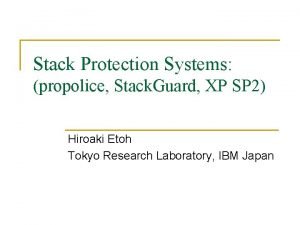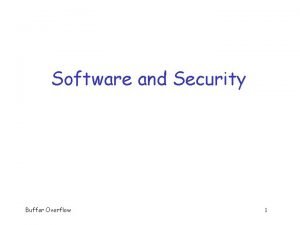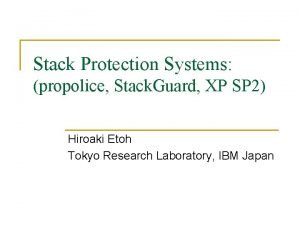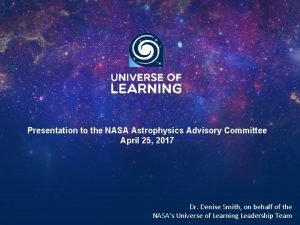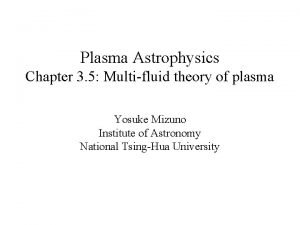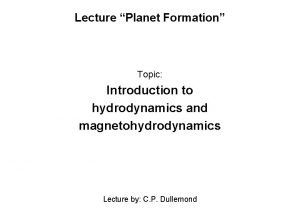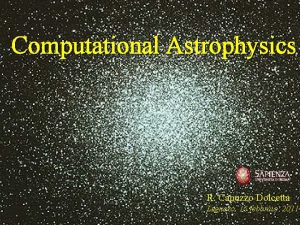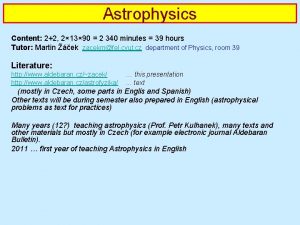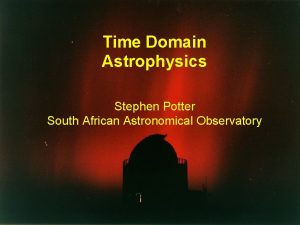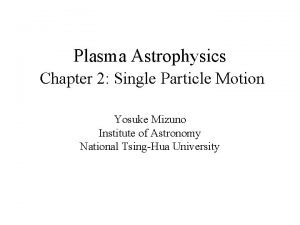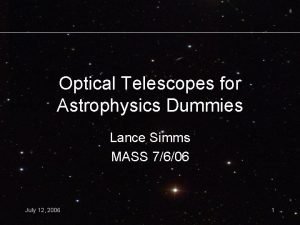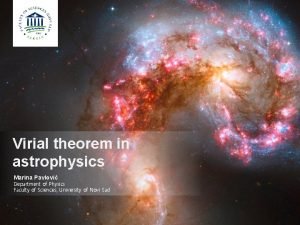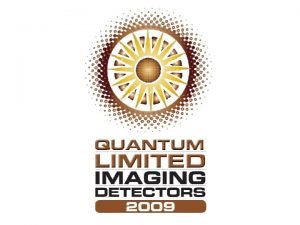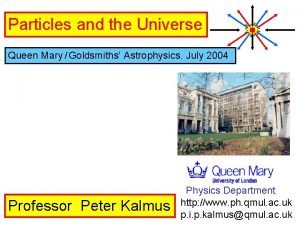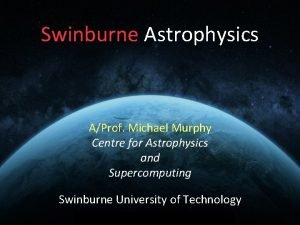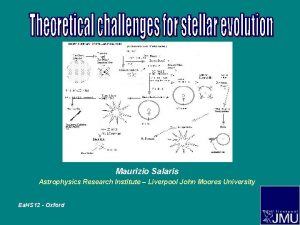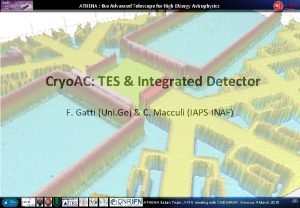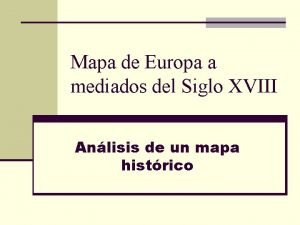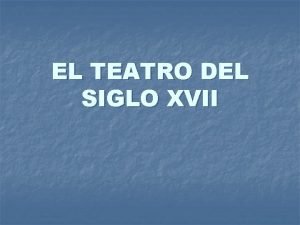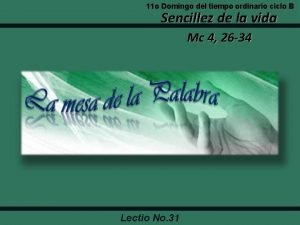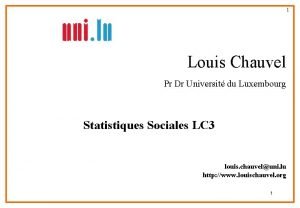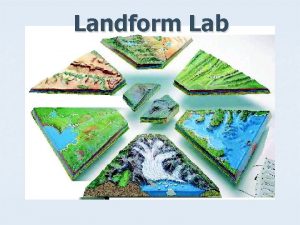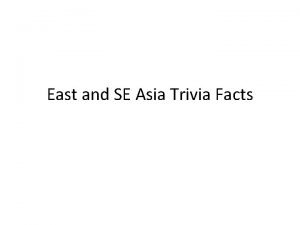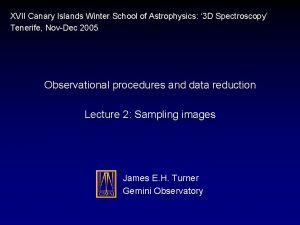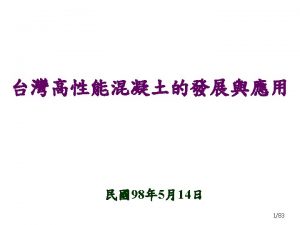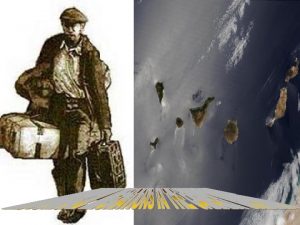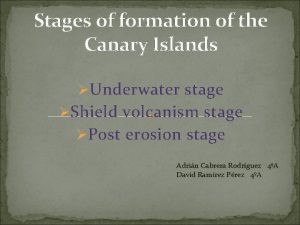XVII Canary Islands Winter School of Astrophysics 3
























































- Slides: 56

XVII Canary Islands Winter School of Astrophysics: ‘ 3 D Spectroscopy’ Tenerife, Nov-Dec 2005 Observational procedures and data reduction Lecture 1: Introduction and observing strategies James E. H. Turner Gemini Observatory

Introduction & observing strategies Introduction: James’s lectures ● Four ~1 -hr lectures on observing and basic data reduction for IFUs – – – Lecture 1 discusses strategies for observing with IFUs ● Optical (visible) and infrared observing techniques ● IFU-specific issues Lecture 2 presents some background on image sampling ● How do we reconstruct the spatial information in raw IFU data? ● How do we best preserve the integrity of the data? Lectures 3 & 4 cover data reduction and data formats ● ● Calibrating and formatting data ready for scientific analysis ( Pierre); removing instrumental and atmospheric effects Optical vs. infrared and fibres vs. microlenses or image slicers

Introduction & observing strategies Introduction: background ● Integral field spectroscopy (IFS) techniques have been in development for at least a couple of decades (Vanderriest, 1980) … but it is only during the last few years (<5) that IFUs have become widely available at major observatories, for everyone to use (with a few exceptions—eg. the Lyon microlens IFUs at CFHT) ● IFS poses new data reduction and analysis issues – It introduces 3 D datasets to mainstream optical/IR astronomy – Spatial information is scrambled (and often not on a square grid) – The software has arguably lagged behind hardware, especially in terms of general-purpose tools ● Hence the Euro 3 D effort, started ~2002 (and, eg. , recent additions to

Introduction & observing strategies Introduction: background ● Now we have new instrumentation and software, but not so much experience with them in the community… – ● Astronomers have been using ‘standard’ spectroscopy for centuries! (and it is technically more straightforward than IFS) The current generation of students and postdocs growing up with IFS will be the ones that spread the expertise within the community

Introduction & observing strategies Start with a quick tour of how IFS compares with other observing modes…

Introduction & observing strategies Observing with IFUs vs. other instruments ● Current IFUs are used at optical (visible) or near-infrared wavelengths – Optical: ~0. 4 -1 mm (CCD detectors); NIR: ~1 -5 mm (Hg. Cd. Te/In. Sb arrays) – In future also mid-IR (JWST MIRI) and far-IR (FIFI-LS on Sofia) sketch based on plot from NASA

Introduction & observing strategies Observing with IFUs vs. other instruments ● IFUs can be dedicated instruments …or insertable modules inside multi-purpose spectrographs SAURON on the WHT (ING newsletter) GNIRS image slicing IFU in the slit slide

Introduction & observing strategies Observing with IFUs vs. other instruments ● We can also have multiple deployable IFU fields within the telescope field of view (like MOS fibres)—more instruments like this in future GIRAFFE multi-IFU design for VLT (Observatoire de Paris? )

Introduction & observing strategies Observing with IFUs vs. other instruments ● Fields of view are typically small – A few arcseconds, compared with arcminutes for typical imagers – Target acquisition is not quite point-and-shoot—but it’s easier than aligning an object with a narrow slit ● ● IFUs have a wider aperture and can provide 2 D images for alignment Some IFUs have larger fields but coarse spatial sampling and/or short spectra – eg. SAURON has a mode with a ~0. 5’ field and ~1” spatial pixels ● Greater field of view for nearby targets ● Better sensitivity for regions of low surface brightness

Introduction & observing strategies Observing with IFUs vs. other instruments ● ● Compared with a slit, IFUs introduce nonuniformities over the field – Have to flat field both the detector and IFU – Together with small field sizes, this makes dithering and mosaicing important—to average over variations and cover a larger area High-res IFUs are a good way to use adaptive optics – Capture more light with an IFU than a very narrow (AO-scale) slit – Acquisition is easier with an IFU than a very narrow slit – Projects that benefit from AO often benefit from 2 D spatial coverage

Introduction & observing strategies More details on optical/NIR observing with IFUs…

Introduction & observing strategies Observing process—typical procedure: optical Science target Acquire target onto the IFU Observe flat/arc If flexure is important (usually is) Nod to sky? Observe science target N Offsets on source? Observe flat/arc

Introduction & observing strategies Observing process—typical procedure: near-IR Science target (with flexure) Observe blank sky Acquire target onto the IFU Observe flats Acquire telluric std onto the IFU Observe telluric std at position A N Observe science target Offsets on source? Observe flats? N ~1 -4 Observe telluric std at position B Standard – before or after

Introduction & observing strategies Observing process—separate calibrations Day time or twilight (dark dome) Daytime flats/arcs? Biases (optical) Darks Special calibrations? Twilight Night time Twilight flats Flux standard (mainly optical)

Introduction & observing strategies Observing process—acquisition (single IFU) ● ● Want to centre the science target at a suitable place in the IFU field – Usually the middle! – Blind telescope pointing rarely gets the target right in the centre of a small IFU field without tweaking – Take a short exposure, measure the target position and move the telescope (or IFU) to adjust it Two approaches: ● Use a normal imaging camera that is fixed with respect to the IFU (maybe another mode of the same instrument) ● Centre the target at co-ordinates known to correspond to the IFU centre

Introduction & observing strategies Observing process—acquisition Direct imaging acquisition onto known ‘hot spot’

Introduction & observing strategies Observing process—acquisition ● Reconstruct a 2 D image of what the IFU is looking at ● Where possible, taking undispersed images through the IFU (or using a single emission line) gives the best sensitivity – ● Rearrange a 1 D slit or set of micropupil spots to a 2 D image Otherwise (maybe to avoid saturation), sum in wavelength or take a spatial cross-section and then rearrange to 2 D Reconstructed acquisition image through the IFU

Introduction & observing strategies Observing process—acquisition ● ● Alternatively, create a 3 D datacube and collapse it in wavelength to make an acquisition image (if it doesn’t take too long!) …or use a direct image to get the target onto the field and then fine-tune the pointing using the IFU For large-pixel IFUs, it may be important that repeated acquisitions (eg. on different nights) are done identically, to allow combining the data optimally Otherwise, there is less of a need for periodic re-acquisition than for a long slit, where the target can drift slowly out of the aperture

Introduction & observing strategies Observing process—object and sky spectra ● ● Once the object is in the right place, we want to keep taking spectra until we get enough signal-to-noise Normally need to observe blank sky as a reference for subtracting out telluric (sky) emission lines and any other background counts – ● For IFUs it is more likely that we have to nod away from the target Optical wavelengths – Can sample the sky at the same time as the target using several methods ● ● Use blank sky from the edges of the IFU field, if the target is small enough Use an IFU with a separate sky field or sky fibres, placed far enough

Introduction & observing strategies Observing process—object and sky spectra Object fibres Sky fibres

Introduction & observing strategies Observing process—object and sky spectra – ● Otherwise, if the target is too extended, we have to nod off to blank sky from time to time and spend <100% of the time observing the target Infrared wavelengths – Standard practice is to nod to sky, usually every other exposure, so we can remove both telluric/thermal emission and detector dark current by subtracting pairs of raw exposures – Have to nod more frequently than in the optical, since sky lines are stronger and vary on timescales of a few minutes – For point-like targets, nod within the IFU field to get 2 the flux – At non-thermal wavelengths (~1 m) and high enough spectral resolution, an alternative for some projects is to spend 100% of the time on source and interpolate over sky lines after dark

Introduction & observing strategies Observing process—object and sky spectra

Introduction & observing strategies Observing process—object and sky spectra

Introduction & observing strategies Observing process—integration times ● ● Exposure times are mainly determined by the same factors as for other spectroscopic modes Minimum exposure – For faint targets, need to integrate long enough for the background noise to overcome the detector read-out noise – It often takes longer to get the same counts per pixel as with a slit: ● – High spatial/spectral resolution IFUs have smaller apertures than a typical slit (since they can have without losing light overall) ● IFUs introduce extra optics (=losses) in the telescope beam ● Sometimes there is extra magnification (=more pixels) involved Frequently the main constraint

Introduction & observing strategies Observing process—integration times ● Maximum exposure – In the infrared, we have to start a new exposure often enough to sample variations in sky lines, for accurate subtraction ● ● – For bright targets, take short exposures (eg. 0. 5 -2 minutes) to sample fast emission-line variations For faint targets, take longer exposures (10 -30 minutes) to average over the fast sky variations Must avoid saturating the detector capacity with too many photons, for bright targets (or perhaps bright sky lines)

Introduction & observing strategies Observing process—integration times – We may want to divide a fixed observing time into multiple exposures for various reasons, such as: ● ● Using repeated samples to help remove cosmic rays ● Dithering on the sky ● ● To allow for changes in flexure between the slit and detector or the telescope image and the IFU Avoiding too much time loss if something goes wrong with an integration Typical exposures are from a few minutes up to 1 hour (optical) or ~20 minutes (infrared)

Introduction & observing strategies Observing process—dithering & mosaicing ● Three reasons for moving where an IFU is pointing on the sky between exposures (other than sky subtraction): ● ‘Dithering’: because IFUs use reflective or transmissive optics, rather than just a clear slit, they tend to introduce artificial spatial structure ● ● ● Flat-field variations, including dead elements such as broken optical fibres Possible variations in spectral line profiles between IFU elements Although flat-fielding removes systematic throughput differences, the resulting noise variations and ‘holes’ due to dead elements remain – Dithering the IFU position with respect to the target object helps to produce a homogeneous dataset and ‘fill in’ any missing spectra – Use small offsets, eg. 1 -2 IFU elements (fibres, slices or lenslets)

Introduction & observing strategies Observing process—dithering & mosaicing ● ‘Mosaicing’: since IFU fields are often just a few arcseconds in size, sometimes we need to observe multiple pointings in order to cover a large enough area of the target ● ● Use offsets comparable to the size of the IFU field, for small overlaps ‘Subsampling’: IFUs with larger fields tend to have coarse spatial pixels that can’t capture all the detail in telescope images ● Try offseting by a fraction of a spatial pixel (fibre, lens, pixel) between frames to get better sampling (like for HST WFPC+Drizzle) – ● eg. steps of 1/2 or 1/3 (smaller increments don’t necessarily gain much) Unlike HST, ground-based observatories have variable seeing and cloud – This may limit the ability to combine data accurately enough – Subsampling is not yet well tested for IFUs, but I’m told it has

Introduction & observing strategies Observing process—dithering & mosaicing ● Observing strategy – Change the telescope pointing slightly between frames, or offset the IFU within the telescope field (if it is movable) – In all 3 cases, we need a way to register the relative positions accurately, so we can combine the data with the right shifts ● For dithering and small mosaics, keeping the centre of the target (eg. galaxy nucleus) inside the field of view at every pointing gives a reliable reference – ● ● Allows up to 4 x the field of view Without at least one reference peak in the field at every position, we need to have well-known pointing offsets, ie. accurate guider (etc. ) movements For subsampling, telescope offsets must be accurate to a small fraction of a spatial pixel …unless there are enough peaks in the field

Introduction & observing strategies Observing process—dithering & mosaicing – In the infrared, dithering & mosaicing may allow spending a larger fraction of time on source than for a single object pointing ● Typical single-pointing sequence: sky-object-sky … ( N) – ● ‘Short cut’ for dithering: sky-object … ( N) – – For faint targets, we achieve best S/N by spending equal time on sky and object so that the background noise is equal in both cases Because we have to shift and add the pointings, we can subtract the same sky from 2 object frames but still have 2 independent sky measurements at any given position In practice, the most conservative schemes give the most accurate sky subtraction (sky-object-sky … or sky-object…)

Introduction & observing strategies Observing process—flat fielding ● Need to measure instrumental efficiency (flat-field) variations, so we can separate them out from real features in the data – Across the detector: pixel-to-pixel variations & other features – Across the IFU field: differences in transmission between different fibres, lenslets or image slices (and possibly along image slices) ● ● Eg. due to fibre stresses/FRD, alignment variations, optical bonding, slicer reflectivity differences, diffraction losses etc. Detector flat exposures – Need a dispersed illumination source that is spectrally smooth ● ● Dispersed to allow for variations in detector response with wavelength etc. Smooth so we can fit and remove the spectral profile of the lamp, leaving just the intrinsic pixel variations

Introduction & observing strategies Observing process—flat fielding – ● Detector flat may also include fringing IFU flat exposures – Need an illumination source that is spatially flat ● The flattest reference is the twilight sky—but there are only a few minutes twice a day to observe this at the right brightness level – ● ● – For IFUs with small spatial pixels and/or high spectral dispersion, it is sometimes necessary to take sky flats when the sun is up! ‘Dome flats’, taken by illuminating a blank spot inside the dome with appropriate lamps, can be relatively flat Given the small sizes of many IFU fields, the calibration source used for detector flats may be flat enough Matching the spatial slit-detector flexure of science exposures is more important than for a long slit, since the apertures are much

Introduction & observing strategies Observing process—flat fielding ● Observing strategy – In the absence of flexure, or if flats are taken frequently enough, we may choose to use a combined detector+IFU flat ● – – Can be taken before or after night-time observations if there is no flexure Where there is flexure (more common), we probably want to take flats at the same telescope pointing as the science data in order to: ● illuminate the same detector pixels in the same way ● help determine the locations of IFU elements on the detector If some optical element (eg. the disperser tilt) moves nonrepeatably. we may need to take flats/arcs before changing instrument configuration

Introduction & observing strategies Observing process—flat fielding Twilight flat l Lamp flat

Introduction & observing strategies Observing process—flat fielding Fibre flat field variations

Introduction & observing strategies Observing process—wavelength calibration ● Want to know the wavelength accurately at each detector pixel – ● ● Measure (and interpolate between) the positions of well-known spectral lines in a reference spectrum Wavelength references – Arc lamp spectrum (eg. Cu. Ar, Th. Ar, Xe, Kr) – Sky emission lines, in the red infrared – Sky absorption lines, primarily in the infrared Observing strategy – Normally get detailed wavelength variation (including nonlinear terms) from an arc lamp exposure

Introduction & observing strategies Observing process—wavelength calibration – Can correct small zero-point shifts due to flexure using sky lines ● – – Observe an arc during the day (or twilight) and shift the zero-point to match each science exposure If there is flexure and no sky lines are available (eg. at high dispersion in the blue), we have to observe arc spectra in between science exposures ● Frequently enough that the telescope pointing doesn’t change much ● Before changing the instrument configuration (eg. grating tilt) Need to calibrate wavelength as a function of pixel index separately for each 1 D fibre or point in a 2 D spectrum

Introduction & observing strategies Observing process—wavelength calibration Optical fibre arc

Introduction & observing strategies Observing process—telluric calibration ● In the infrared (and far red), telluric absorption lines are important – The I/z/J/H/K/L/M bandpasses are defined in spectral regions with reasonable atmospheric transmission, but there are still many minor absorption features within the bands, eg. due to water vapour ● Occasionally we may even want to work in between clean bands, eg. to measure a strong emission line that is redshifted from the visible – The amount of absorption scales with airmass and varies with time – For most purposes, telluric absorption in the science data is bad news ● Confuse telluric lines with stellar features—especially when using an automatic algorithm to measure velocities, for example

Introduction & observing strategies Observing process—telluric calibration G star, with telluric features

Introduction & observing strategies Observing process—telluric calibration ● Observing strategy – To calibrate telluric features, observe a star of known spectral type, with little or no intrinsic absorption at wavelengths of interest (eg. A type) ● ● – Immediately before or after the corresponding science observation At an RA & Dec chosen to match the airmass (ie. elevation / zenith distance) of the science target – Match the average airmass during the science observation, where the range of variation is relatively small (eg. <0. 3 airmasses). – For longer observations, bracket the range of airmass of the science observation with telluric standards before and after If the instrument’s spectral profile varies over the IFU field, we might dither the star around the IFU to get light through different

Introduction & observing strategies Observing process—flux calibration ● In order to compare fluxes meaningfully, we have to account for: ● Instrumental efficiency variation as a function of wavelength ● ● ● Eg. if we want to measure the true continuum slope of the target or take line ratios from different ends of the spectrum The total throughput / sensitivity of the instrument + telescope + sky ● ● Spectral equivalent of flat-fielding the IFU spatially If we want to determine the absolute brightness of the source or a particular spectral feature (and the observing conditions permit this) Observing strategy – Derive an instrumental sensitivity spectrum by observing a standard star with well-known intrinsic brightness as a function of wavelength

Introduction & observing strategies Observing process—flux calibration

Introduction & observing strategies Observing process—flux calibration – In the visible, there are numerous spectrophotometric standards with brightness already tabulated as a function of wavelength (eg. Oke, 1990) – In the IR, we often observe a star with just a well-known broadband magnitude and spectral type ● Model the intrinsic continuum using a black-body curve for the appropriate temperature and magnitude and compare with the real data – Standards can be observed occasionally during a given observing run – If we’re only interested in correcting the relative throughput variation with wavelength then it’s OK to observe through cloud (which is grey) – Line strengths (equivalent widths) can still be measured relative to

Introduction & observing strategies Observing process—flux calibration ● IFU vs. long slit – For slit spectroscopy, if we need absolute flux calibration we have to use a special wide slit in order to capture all the light from the standard star ● Wider slit = lower spectral resolution than for the science data ● IFUs can capture all the light without affecting the spectral resolution – – Can possibly use a single standard observation for both telluric calibration and absolute flux calibration For narrow slits, atmospheric dispersion causes colour-dependent throughput losses unless observing at the parallactic angle ● Relative flux calibration is also easier and more accurate with an IFU

Introduction & observing strategies Observing process—detector bias ● Need to determine the zero-point readout level of each detector pixel, so we can measure the accumulated counts above that level – For CCD detectors, take a few very short exposures in the dark ● ● – Average together several such exposures to overcome read-out noise Infrared arrays are normally read out by subtracting the difference in counts between the start and end of each exposure ● – Gives the value in each pixel when no electrons are stored The bias level is removed automatically, so there is no need to measure it separately Why the difference? ● IR arrays can be read out quickly without affecting the stored charge,

Introduction & observing strategies Observing process—detector bias Biases are the dullest thing you will get to observe! ● Observing strategy (CCDs) – The bias level is typically stable enough to take occasional reference exposures during the daytime – Sometimes an overscan region is created for each exposure by continuing to read out the detector after shuffling out all the accumulated charge ● Allows an overall zero-point correction to be made if necessary, on top of the pixel-to-pixel differences from the bias exposures

Introduction & observing strategies Observing process—dark current ● During an exposure, detector pixels accumulate some electrons due to thermal excitation & array defects, as well as from incident photons – ● ● The detector is cooled to minimize thermal current, but too much cooling would cause the quantum efficiency to drop For modern CCDs, the dark current may be low enough not to matter (eg. 1 e- / hr) For infrared arrays, the dark current is higher and tends to vary strongly between pixels – Hot pixels obscure features in the raw images – Need a reference to separate dark current from counts due to

Introduction & observing strategies Observing process—dark current High dark-current pixels in a raw NIR spectrum

Introduction & observing strategies Observing process—dark current ● Observing strategy: for science data – For a given exposure time, the dark current can be determined by exposing the detector in complete darkness for the same length of time ● – Average several dark exposures to account for read noise and cosmic rays When taking separate sky exposures, the same dark current is present in both object and sky frames (assuming the exposures are equal) ● ● In the infrared, subtracting object-sky pairs removes dark current automatically, without the need for special calibrations Usually many of the hot pixels subtract out well, leaving just a statistical increase in noise (the remainder have to be masked out during reduction)

Introduction & observing strategies Observing process—dark current ● ● Observing strategy: for calibrations – For flat-field observations, equal dark (or ‘lamps off’) exposures must be taken if the flats are long enough to have significant dark current – For arc lamp exposures, darks are needed if uncorrected hot pixels appear as spikes that could be confused with real emission lines In short: – In the IR, one typically takes darks for flat fields; for on-sky exposures they are optional, depending on the reduction method ● – It’s time-consuming to take darks for science exposures of ≥ 10 min! In the optical darks aren’t always needed with modern detectors

Introduction & observing strategies Observing process—disclaimer ● Small details vary a lot between different instruments – Especially when it comes to configuring the instrument, repeatibility etc. – Get advice from your observatory contact scientist!! – If your projects are queue scheduled, visit the telescope for a month anyway and help out… you’ll understand your data better!

Introduction & observing strategies Observing process—disclaimer ● Small details vary a lot between different instruments – Especially when it comes to configuring the instrument, repeatibility etc. – Get advice from your observatory contact scientist!! – If your projects are queue scheduled, visit the telescope for a month anyway and help out… you’ll understand your data better! ● (Observatories like cheap labour)

Introduction & observing strategies Summary ● On the whole, observing with a single IFU isn’t too different from standard slit spectroscopy – ● As usual, we have different techniques in the optical and near-IR A number of details are different from other spectroscopic modes (some are more like imaging, since IFUs do that too): – Target acquisition ● – Data inspection ● – 2 D image reconstruction through the IFU Have to learn how to read the scrambled images and/or use special software Flat fielding requirements ● Spatial structure due to the IFU as well as the detector

Introduction & observing strategies Summary – – Sky subtraction strategies ● Optical: eg. use separate sky fibres instead of the ends of a slit ● NIR: eg. nod off to sky instead of up and down a slit Spatial dithering and mosaicing ● – ● Large and small offsets in both dimensions Sensitivity ● Difficult to go faint with a high-res IFU (want a 30 m/100 m telescope!) ● Can do better with large-pixel IFUs Next lecture: Sampling images

Introduction & observing strategies Summary – – Sky subtraction strategies ● Optical: eg. use separate sky fibres instead of the ends of a slit ● NIR: eg. nod off to sky instead of up and down a slit Spatial dithering and mosaicing ● – ● Large and small offsets in both dimensions Sensitivity ● Difficult to go faint with a high-res IFU (want a 30 m/100 m telescope!) ● Can do better with large-pixel IFUs Next lecture: Sampling images irac D h t i w te Comple ons! i t c n u f delta
 Canary tsunami threat
Canary tsunami threat Canary islands gdp
Canary islands gdp Winter kommt winter kommt flocken fallen nieder
Winter kommt winter kommt flocken fallen nieder Heute mittwoch guten morgen mittwoch winter
Heute mittwoch guten morgen mittwoch winter Es war eine mutter
Es war eine mutter Basic working of stack guard is
Basic working of stack guard is Canary buffer overflow
Canary buffer overflow Brownfield sites canary wharf
Brownfield sites canary wharf Famlya
Famlya Propolice
Propolice Working with models
Working with models Astrophysics equations
Astrophysics equations Astrophysics equations
Astrophysics equations Astrophysics
Astrophysics 13,90/2
13,90/2 Time domain astrophysics
Time domain astrophysics Astrophysics
Astrophysics Astrophysics for dummies
Astrophysics for dummies Virial theorem in astrophysics
Virial theorem in astrophysics Rit astrophysics
Rit astrophysics Queen mary astrophysics
Queen mary astrophysics Swinburne astrophysics
Swinburne astrophysics Liverpool astrophysics
Liverpool astrophysics Advanced telescope for high energy astrophysics
Advanced telescope for high energy astrophysics French plan xvii
French plan xvii Salmo xvii
Salmo xvii Salmo 17 quevedo
Salmo 17 quevedo El realismo en el siglo xvii
El realismo en el siglo xvii Mapa de europa del siglo xviii
Mapa de europa del siglo xviii El teatro del siglo xvii
El teatro del siglo xvii Ecco la fiera con la coda aguzza
Ecco la fiera con la coda aguzza Najkrótszy tren jana kochanowskiego
Najkrótszy tren jana kochanowskiego Sonnet xvii neruda
Sonnet xvii neruda Budowle barokowe w europie
Budowle barokowe w europie Domingo xvii tiempo ordinario ciclo c
Domingo xvii tiempo ordinario ciclo c Xvii domenica tempo ordinario anno b
Xvii domenica tempo ordinario anno b 17 cd poggiofranco bari
17 cd poggiofranco bari Domingo xvii tiempo ordinario ciclo a
Domingo xvii tiempo ordinario ciclo a Lectura del domingo
Lectura del domingo Lecturas del domingo xvii del tiempo ordinario ciclo b
Lecturas del domingo xvii del tiempo ordinario ciclo b Domingo 30 del tiempo ordinario ciclo b
Domingo 30 del tiempo ordinario ciclo b Lírica renacentista (siglos xvi-xvii)
Lírica renacentista (siglos xvi-xvii) Los austrias menores
Los austrias menores Louis xvii
Louis xvii Ducksters
Ducksters Mitoc winter school
Mitoc winter school Winter law school elsa
Winter law school elsa School crossing patrol coats
School crossing patrol coats Wizer constructive and destructive forces
Wizer constructive and destructive forces What hemisphere is japan in
What hemisphere is japan in Israel vs faroe isla
Israel vs faroe isla Why did the athenians sail to nearby islands in panic?
Why did the athenians sail to nearby islands in panic? Deforestation in andaman and nicobar islands
Deforestation in andaman and nicobar islands Spanish speaking islands
Spanish speaking islands A set of closely grouped islands
A set of closely grouped islands Bionicle islands
Bionicle islands A group or chain of islands clustered together
A group or chain of islands clustered together





